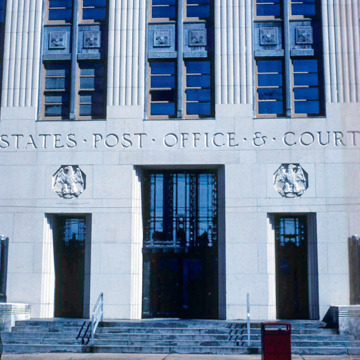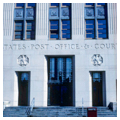Alexandria is fortunate to have two extremely fine Art Deco courthouse buildings constructed in the 1930s: this one, dating from the early 1930s, and the Rapides Parish Courthouse begun in 1939 at 701 Murray Street. Designed by Shreveport architect Edward F. Neild under the supervision of the Treasury Department, this federal courthouse has a white granite base, and its upper three stories are faced with a light buff limestone. The central nine bays are slightly taller than the wings, which are also quite narrow, just one bay in width. Fluted pilasters separate the windows, and above them are stylized cross motifs. The entrance doors are slightly recessed between fluted jambs and are flanked by bas reliefs of eagles. Bronze grilles across the top of the three entrance doors depict the evolution of mail transport in designs by Arthur C. Morgan: packet boat, stagecoach, steamship, train, and airplane. While the building’s exterior ornamentation is limited in amount, it is designed and placed to enhance architectural features. Originally, the building’s first floor accommodated postal services, while the two upper floors were used for judicial functions. Although the post office section now functions only as a substation, the vestibule and the lobby retain most of their original detailing. These splendid interior spaces have marble walls, terrazzo floors, aluminum-framed light fixtures encasing opaque glass, metal mailboxes set within an oak surround, and a marble staircase. Unfortunately, the upper floors have largely been remodeled.
You are here
U.S. Courthouse and Post Office
1932–1933, James A. Wetmore, Supervising Architect of the U.S. Treasury, and Edward F. Neild. 515 Murray St.
If SAH Archipedia has been useful to you, please consider supporting it.
SAH Archipedia tells the story of the United States through its buildings, landscapes, and cities. This freely available resource empowers the public with authoritative knowledge that deepens their understanding and appreciation of the built environment. But the Society of Architectural Historians, which created SAH Archipedia with University of Virginia Press, needs your support to maintain the high-caliber research, writing, photography, cartography, editing, design, and programming that make SAH Archipedia a trusted online resource available to all who value the history of place, heritage tourism, and learning.




